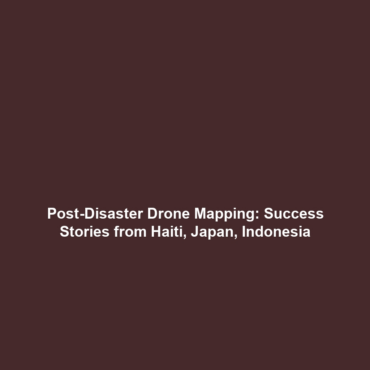Drones in Science: Examples of Drones Used to Map Post-Disaster Areas in Haiti, Japan, and Indonesia
The application of drones in scientific research has gained significant traction, particularly in the aftermath of natural disasters. Drones are revolutionizing how we assess damage and map areas affected by catastrophes like earthquakes, hurricanes, and tsunamis. This article delves into notable examples of drone technology employed in post-disaster assessments in Haiti, Japan, and Indonesia, highlighting their importance within the broader context of drones in science.
Key Concepts of Drones in Damage Assessment
Drones equipped with advanced imaging technologies play a crucial role in mapping post-disaster areas. Here are some key concepts and principles associated with their use:
- Remote Sensing: Drones utilize cameras and LiDAR systems to capture high-resolution images of disaster zones.
- Geographic Information Systems (GIS): GIS technology aids in analyzing collected data for mapping and visualization purposes.
- Real-Time Data Collection: Drones can quickly survey areas, providing timely information that guides response efforts.
Applications and Real-World Uses
Drones have become integral to the assessment of damaged areas in several countries. Here are notable applications of drones in post-disaster scenarios:
Haiti
In the aftermath of the 2010 earthquake, drones were utilized to assess extensive damage in Port-au-Prince, providing rapid assessments that informed rebuilding efforts.
Japan
Following the 2011 tsunami, drones mapped the coastline and collected data to assist in recovery operations, showcasing their efficiency in disaster response.
Indonesia
Drones have been dispatched to assess damage after frequent earthquakes and tsunamis, tracking debris and identifying unsafe areas for evacuation.
These examples illustrate how drones are utilized for mapping post-disaster areas effectively, thereby enhancing scientific understanding and emergency response.
Current Challenges in Drone Applications
Despite their potential, several challenges limit the effectiveness of drones in mapping post-disaster areas:
- Regulatory Issues: Compliance with local regulations can restrict drone operations.
- Technical Limitations: Drones may have constraints in terms of payload capacity and flight duration under adverse conditions.
- Data Privacy Concerns: The use of drones raises ethical questions about surveillance and privacy in affected communities.
Future Research and Innovations
Looking ahead, several innovations are anticipated to enhance drone applications in disaster mapping:
- Artificial Intelligence: AI integration is expected to improve data analysis, making it easier to process and interpret collected information.
- Autonomous Drones: Development of fully autonomous drones capable of operating without human intervention will expand their deployment capabilities.
- Enhanced Imaging Technologies: Advancements in multispectral imaging could yield more detailed assessments of damage and environmental impact.
Conclusion
In summary, the use of drones to map post-disaster areas in Haiti, Japan, and Indonesia exemplifies the critical role of drones in science. Their capability to quickly assess damage and collect data is invaluable in emergency response and planning. As technology advances, the future of drone applications in this field looks promising. For further reading, explore our pages on emerging drone technologies and global case studies of drones in disaster management.
